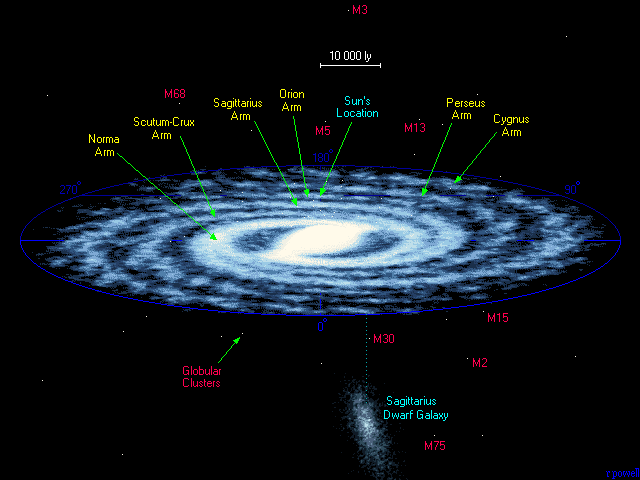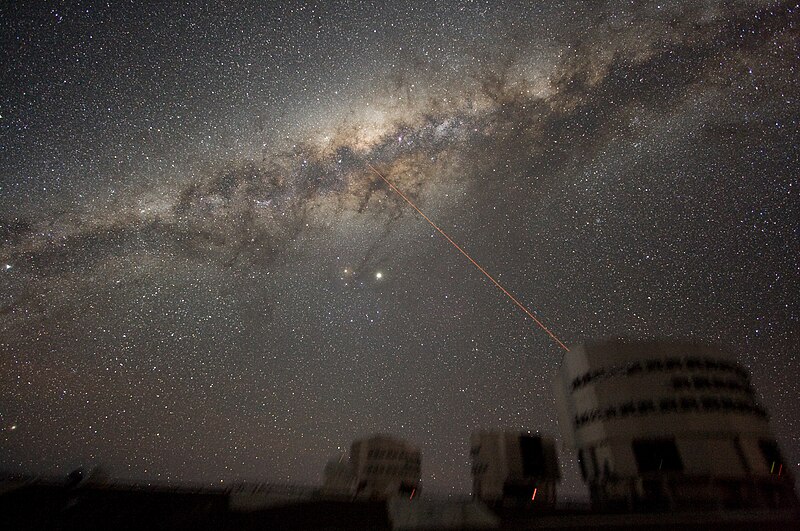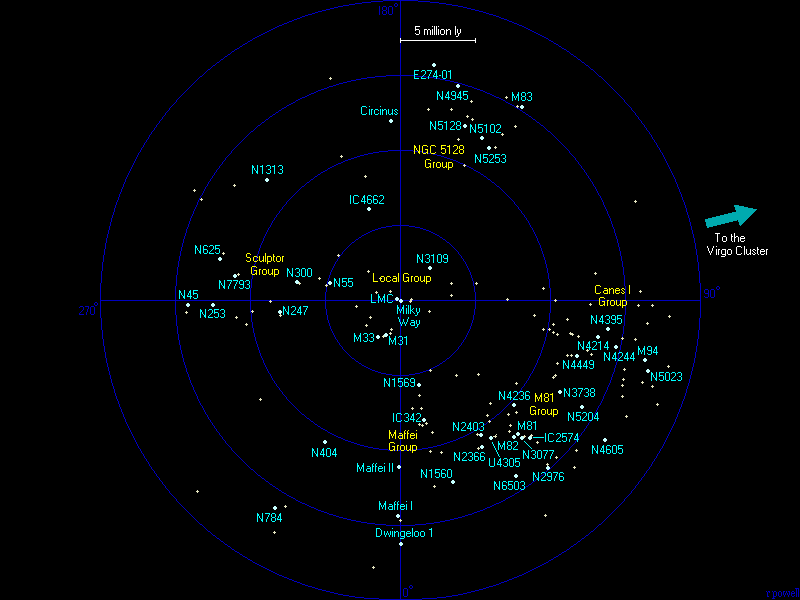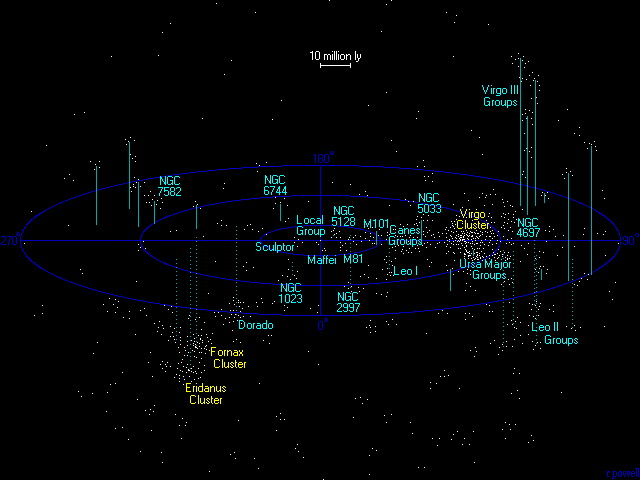FCUHOMESCHOOLING ASTRONOMY CLASS
SIZE OF THE OBSERVABLE UNIVERSE IN PERSPECTIVE
The age of the universe is about 13.75 billion years. The diameter of the observable universe is estimated at about 28 billion parsecs (93 billion light-years). As a reminder, a light-year is a unit of length equal to just under 10 trillion kilometres (or about 6 trillion miles).
The Observable Universe consists of the galaxies and other matter that we can, in principle, observe from Earth in the present day—because light (or other signals) from those objects has had time to reach the Earth since the beginning of the cosmological expansion.
The word observable used in this sense does not depend on whether modern technology actually permits detection of radiation from an object in this region (or indeed on whether there is any radiation to detect). It simply indicates that it is possible in principle for light or other signals from the object to reach an observer on Earth.
The numbers are pretty hard to comprehend even when you know what each unit represents. To even think of how long 10 trillion kilometers might be, let alone 93 billion times that distance, can cause your brain to hurt. Andrew Z. Colvin has attempted to put some of this incomprehensible size into perspective by starting with our own planet and zooming out from there.
1. EARTH
2. SOLAR SYSTEM
The Solar System consists of the Sun and its planetary system of 8 planets, their moons, and other non-stellar objects. It formed 4.6 billion years ago from the collapse of a giant molecular cloud. The vast majority of the system's mass is in the Sun, with most of the remaining mass contained in Jupiter.
The four smaller inner planets, Mercury, Venus, Earth and Mars, also called the terrestrial planets, are primarily composed of rock and metal.
The four outer planets, called the gas giants, are substantially more massive than the terrestrials. The two largest, Jupiter and Saturn, are composed mainly of hydrogen and helium; the two outermost planets, Uranus and Neptune, are composed largely of substances with relatively high melting points, called ices, such as water, ammonia and methane, and are often referred to separately as "ice giants". All planets have almost circular orbits that lie within a nearly flat disc called the ecliptic plane.
The four smaller inner planets, Mercury, Venus, Earth and Mars, also called the terrestrial planets, are primarily composed of rock and metal.
The four outer planets, called the gas giants, are substantially more massive than the terrestrials. The two largest, Jupiter and Saturn, are composed mainly of hydrogen and helium; the two outermost planets, Uranus and Neptune, are composed largely of substances with relatively high melting points, called ices, such as water, ammonia and methane, and are often referred to separately as "ice giants". All planets have almost circular orbits that lie within a nearly flat disc called the ecliptic plane.
Accretion:
The process in which planetessimals, and sometimes planets, are formed.
1) Gas particles and dust stick together due to the electrostatic attraction.
2) They continue to stick to each other and grow larger and larger.
3) As they grow larger, their gravity was strong enough to attract particles (in addition to the electrostatic attraction) and the growth sped up.
4) Growth continues.
5) It grows large enough for gravity to pull all the contents of the planetessimal into a spherical shape.
6) As it grows, gravity becomes stronger, and the growth speeds up and it takes all of the material around it in. It is similar to the snowball effect.
\
3. SOLAR INTERSTELLAR NEIGHBOURHOOD

Created by Andrew Z. Colvin
4. MILKY WAY

Created by Andrew Z. Colvin
The Milky Way is the galaxy that contains our Solar System. This name derives from its appearance as a dim "milky" glowing band arching across the night sky, in which the naked eye cannot distinguish individual stars.
The Milky Way is a barred spiral galaxy 100,000–120,000 light-years in diameter containing 200–400 billion stars. It may contain at least as many planets.[17] The Solar System is located within the disk, around two thirds of the way out from the Galactic Center, on the inner edge of a spiral-shaped concentration of gas and dust called the Orion–Cygnus Arm.
This is the Milky Way, the Galaxy we belong to. Image of the night sky above Paranal on 21 July 2007, taken by ESO astronomer Yuri Beletsky. A wide band of stars and dust clouds, spanning more than 100 degrees on the sky, is seen. At the centre of the image, two bright objects are visible. The brightest is the planet Jupiter, while the other is the star Antares. Three of the four 8.2-m telescopes forming ESO's VLT are seen, with a laser beaming out from Yepun, Unit Telescope number 4. The laser points directly at the Galactic Centre. Also visible are three of the 1.8-m Auxiliary Telescopes used for interferometry. They show small light beams which are diodes located on the domes. The exposure time is 5 minutes and because the tracking was made on the stars, the telescopes are slightly blurred.
5. LOCAL GALACTIC GROUP
 Created by Andrew Z. Colvin
Created by Andrew Z. Colvin
The Local Group is the group of galaxies that includes Earth's galaxy, the Milky Way. The group comprises more than 54 galaxies (including dwarf galaxies), with its gravitational center located somewhere between the Milky Way and the Andromeda Galaxy. The galaxies of the Local Group cover a diameter of 10 megalight-years (3.1 megaparsecs) (see 1 E+22 m for distance comparisons) and have a binary (dumbbell)[1] distribution. The group is estimated to have a total mass of 1.29±0.14 ×1012 M☉[1] and has a velocity dispersion of 61±8 km/s.[2] The group itself is part of the Virgo Supercluster (i.e. the Local Supercluster).[3]
The three most massive members of the group are the Andromeda Galaxy, the Milky Way Galaxy and Triangulum Galaxy.
| Spiral galaxies | |||
|---|---|---|---|
| name | type | constellation | notes |
| Andromeda Galaxy (M31, NGC 224) | SA(s)b | Andromeda | Largest member of the group, recently (2006) discovered to also be a barred spiral. May be less massive than the Milky Way. |
| Milky Way | SBbc | n/a | Second largest, though possibly most massive galaxy in the group.[6] |
| Triangulum Galaxy (M33, NGC 598) | SA(s)cd | Triangulum | Third largest, only unbarred spiral galaxy and possible satellite of the Andromeda Galaxy. |
6. VIRGO SUPERCLUSTER

The Virgo Supercluster (Virgo SC) or Local Supercluster (LSC or LS) is the irregular supercluster that contains the Virgo Cluster in addition to the Local Group, which in turn contains the Milky Way and Andromeda galaxies. At least 100 galaxy groups and clusters are located within its diameter of 33 megaparsecs (110 million light-years). It is one of millions of superclusters in the observable Universe.
7. LOCAL SUPERCLUSTERS

Created by Andrew Z. Colvin
Some of the groups in LOCAL SUPERCLUSTERS ie. LOCAL GROUP, SCULPTOR GROUP, CANES 1 GROUP,MAFFEI GROUP, NGC 5128 and M81 GROUP.
Some of clusters in LOCAL SUPERCLUSTERS ie. VIRGO CLUSTER, FORNAX CLUSTER and ERIDANUS CLUSTER.
8. THE OBSERVABLE UNIVERSE

Created by Andrew Z. Colvin
The observable universe, also known as the Hubble volume, is the region of space that it is theoretically possible for us to observe, small enough that light from the furthest regions has had sufficient time to reach Earth since the Big Bang. This region of space has a diameter of approximately 92.94 billion light-years, centered on the planet Earth. Each different portion of space has its own visible universe, some overlapping, some not.
To know the real size of universe : http://scaleofuniverse.com/
source:








